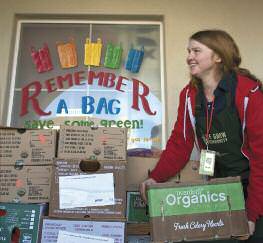edible endeavors
TRACTORS, TAILS, AND TEAMWORK
Sometimes the best farm workers get paid in kibble.
WRITTEN BY BARBARA TWITCHELL
PHOTOS BY SHEA EVANS
The woman utters a simple command, her voice quiet but firm, almost inaudible above the brisk breeze. The slender black-and-white dog some 20 yards in the distance immediately responds, returning to her master’s side.
Janet Hunter and her dog, Susie, continue on with their farm chores on this chilly afternoon. Susie rounds up the sheep, moving them from the pasture to a pen near the barn. Bounding off to an outlying field, Susie herds the cows to the place Hunter indicates, this time following signals emanating from Hunter’s small, triangular whistle. Susie proves equally adept at following both verbal and whistle commands.
Watching the pair work together, one cannot help but notice something else. Subtle cues — a look, a nod, a tilt of the head — create an intimate, nonverbal dialogue. It’s a communication that appears almost telepathic at times.
Ask any farmer or rancher, and they will tell you that a canine partner like this is worth its weight in gold and a vital part of herding life.

Natural instincts
Herding dogs have played an important role in agriculture dating back to ancient times. These animals have been selectively bred for hundreds of years to work with certain types of livestock in specific ways. As a result, the herding characteristics of each breed are innate.
Hunter, who not only uses herding dogs on her Side by Side Ranch in Doyle, Calif., but also is a highly regarded breeder and trainer, stresses the importance of this inherent drive.
“You can’t teach them to herd. They know how to do that instinctively,” Hunter says. “With training, you’re trying to teach them to build a language, so you can let them know how and when you want it done.”
Border collies, such as Susie, are the top dogs in this category. They are extremely intelligent, agile, dedicated, and tireless. Their body type, energy level, and endurance are particularly well suited to Northern Nevada’s wide-open spaces and high-desert terrain, according to Hunter. Border collie mixed breeds also do quite well in this region, as do Australian shepherds, cattle dogs, and kelpies.
Workin’ it
As Wendy Baroli drives by on a tractor, her canine passenger, Frankie, gives a happy tail wag. Typical of the border collie breed, Frankie loves to work — as hard and as long as she can.
She’s just helped Baroli round up some escapee pigs at GirlFarm, in North Reno, skillfully returning the fugitive swine to their pen. It’s apparent from the contented look on Frankie’s face that few things could be more satisfying for a herding dog.
Baroli and Hunter cannot say enough about the value of these dogs on a working farm.
“They outwork just about any human, never complain, and ask for very little other than your devotion in return,” Baroli says.
Hunter adds that they also are fiercely protective. She cites an incident when one of her dogs protected her from a charging cow, likely saving her life. Baroli offers similar accounts.
Nonetheless, Hunter points out that herding dogs should never be expected to protect livestock from predators. That is the job of another farm/ranch working canine — the guardian dog. Composed of larger breeds, guardian dogs live as full-time members of the flock or herd they defend. Guardians bond with their livestock while herding dogs bond with their humans. Their protective instincts and allegiances match accordingly.
“Herding dogs are part of your family,” Hunter says. “They’re your companions. They’re your partners.”
But she warns that though the bond with these dogs is deep and strong, there are boundaries that must be established with breeds as smart, capable, and determined as herders.
“You always have to be alpha,” Hunter warns. “They will try to reverse the role. Susie did it today. She wanted to be puppy in charge.”
Susie looks up at her with serious eyes and a quizzical tilt to her head. Hunter gazes down at the dog and responds softly, “I’m just telling the truth.”
Can’t say for sure, but Susie actually seems to smile.
Writer Barbara Twitchell’s beloved dog, Bucky, passed away the very day she did this interview. She wishes to dedicate this story to him, and all the wonderful dogs that bring so much joy, enrichment, and love to our lives.
For details about training a herding dog, contact Hunter at http://www.Sidebysideranch.com.
Ranch guardians
Herding dogs are not the only invaluable working dogs used on local ranches. Guardian dogs are used to protect livestock from predators. Many different types of dogs are used for this purpose, but popular breeds include Maremma sheepdogs, Akbashes, Great Pyrenees shepherds, kangals, Armenian gamprs, tornjaks, karakachans, and Anatolian shepherds, and mastiffs.


